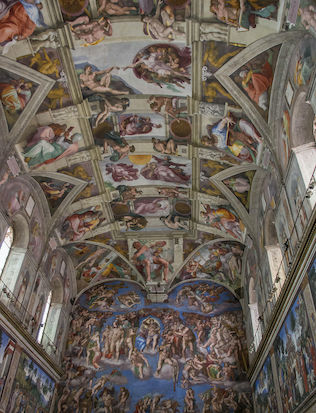For some reason I have been thinking a lot about frames and edges lately: the places where works of art begin and end, and where they meet the world that surrounds them. Both are vital aspects of the experience of art, and both are peculiarly ill served by the reproduction, which habitually turns every picture into a disembodied slide or screen-grab: scaleless, placeless, whirled into the great sensorium of our increasingly virtual world.
There is no better example of the way in which a work of art can be denatured by reproduction (none that I can think of, anyway) than the fate that has befallen perhaps the most famous work of art in the world: Michelangelo's Sistine Chapel ceiling. It is very difficult to think of Michelangelo's masterpiece without calling to mind certain details made world famous by the croppings and the blow-ups of reproductive process: above all, perhaps, the hand of God outstretched towards the hand of Adam; but also the many achingly beautiful figures that are Michelangelo's ignudi, which stand alone so well as isolated images, extracted to an ideal art gallery. But to become fixated on such details is to become oblivious to the actual meaning, the grand and even terrifying majesty of Michelangelo's entire scheme. The only way to appreciate how the whole of his pictorial machine works - and it is a great machine, every part locked to every other - is actually to stand underneath it and submit to the implacability of its design. The ceiling's meaning is linked irrevocably to its frame, which is in effect the very building that contains it: the central chapel of Christendom, as it was in Michelangelo's time. The last time I was there, I was struck by the overpowering momentum of the painter's design: in particular,...


